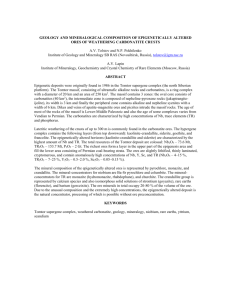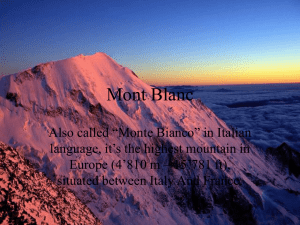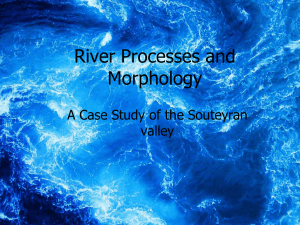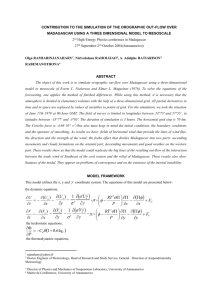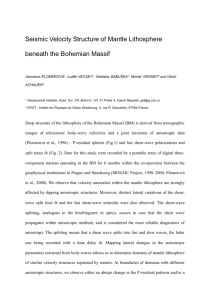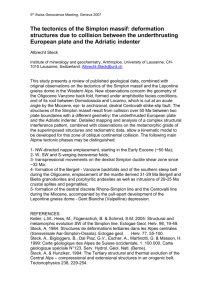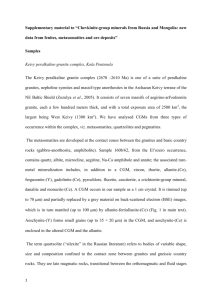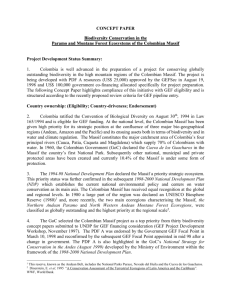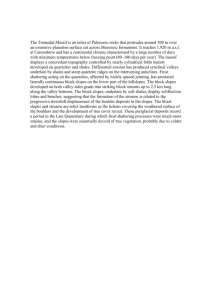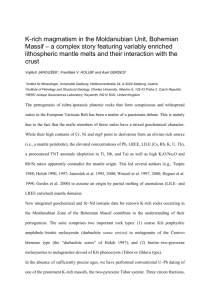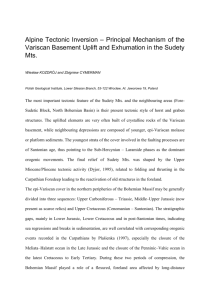Lebedev1 VI, Kozakov3 IK, Yarmolyuk2 VV, Kovach3 VP and
advertisement
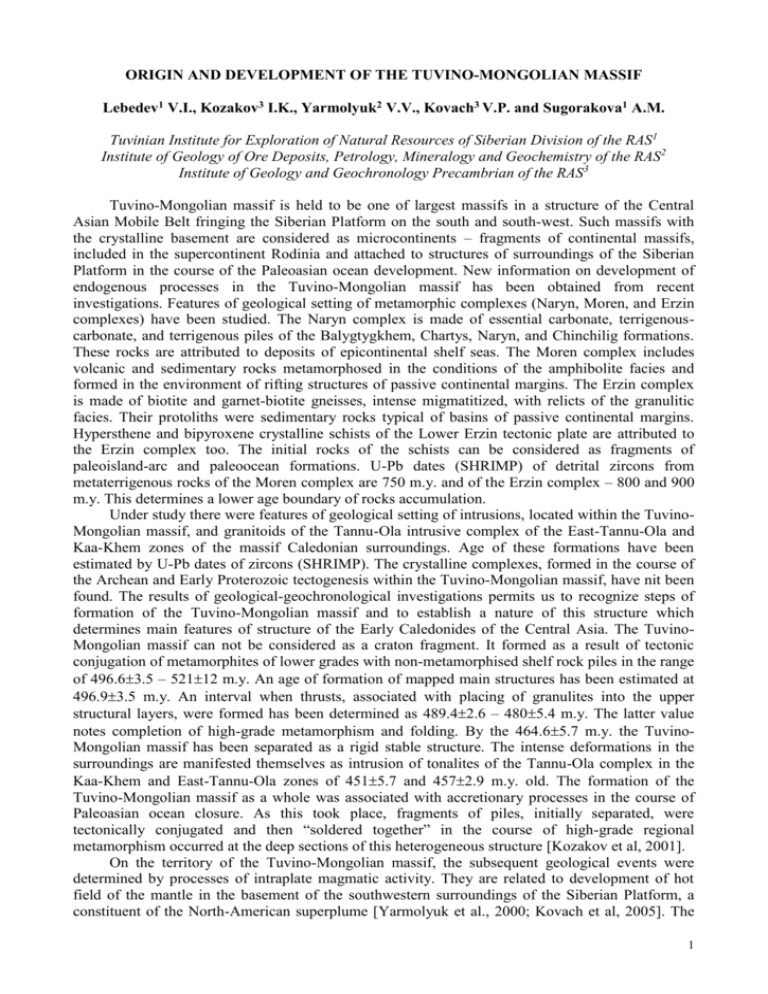
ORIGIN AND DEVELOPMENT OF THE TUVINO-MONGOLIAN MASSIF Lebedev1 V.I., Kozakov3 I.K., Yarmolyuk2 V.V., Kovach3 V.P. and Sugorakova1 A.M. Tuvinian Institute for Exploration of Natural Resources of Siberian Division of the RAS1 Institute of Geology of Ore Deposits, Petrology, Mineralogy and Geochemistry of the RAS2 Institute of Geology and Geochronology Precambrian of the RAS3 Tuvino-Mongolian massif is held to be one of largest massifs in a structure of the Central Asian Mobile Belt fringing the Siberian Platform on the south and south-west. Such massifs with the crystalline basement are considered as microcontinents – fragments of continental massifs, included in the supercontinent Rodinia and attached to structures of surroundings of the Siberian Platform in the course of the Paleoasian ocean development. New information on development of endogenous processes in the Tuvino-Mongolian massif has been obtained from recent investigations. Features of geological setting of metamorphic complexes (Naryn, Moren, and Erzin complexes) have been studied. The Naryn complex is made of essential carbonate, terrigenouscarbonate, and terrigenous piles of the Balygtygkhem, Chartys, Naryn, and Chinchilig formations. These rocks are attributed to deposits of epicontinental shelf seas. The Moren complex includes volcanic and sedimentary rocks metamorphosed in the conditions of the amphibolite facies and formed in the environment of rifting structures of passive continental margins. The Erzin complex is made of biotite and garnet-biotite gneisses, intense migmatitized, with relicts of the granulitic facies. Their protoliths were sedimentary rocks typical of basins of passive continental margins. Hypersthene and bipyroxene crystalline schists of the Lower Erzin tectonic plate are attributed to the Erzin complex too. The initial rocks of the schists can be considered as fragments of paleoisland-arc and paleoocean formations. U-Pb dates (SHRIMP) of detrital zircons from metaterrigenous rocks of the Moren complex are 750 m.y. and of the Erzin complex – 800 and 900 m.y. This determines a lower age boundary of rocks accumulation. Under study there were features of geological setting of intrusions, located within the TuvinoMongolian massif, and granitoids of the Tannu-Ola intrusive complex of the East-Tannu-Ola and Kaa-Khem zones of the massif Caledonian surroundings. Age of these formations have been estimated by U-Pb dates of zircons (SHRIMP). The crystalline complexes, formed in the course of the Archean and Early Proterozoic tectogenesis within the Tuvino-Mongolian massif, have nit been found. The results of geological-geochronological investigations permits us to recognize steps of formation of the Tuvino-Mongolian massif and to establish a nature of this structure which determines main features of structure of the Early Caledonides of the Central Asia. The TuvinoMongolian massif can not be considered as a craton fragment. It formed as a result of tectonic conjugation of metamorphites of lower grades with non-metamorphised shelf rock piles in the range of 496.63.5 – 52112 m.y. An age of formation of mapped main structures has been estimated at 496.93.5 m.y. An interval when thrusts, associated with placing of granulites into the upper structural layers, were formed has been determined as 489.42.6 – 4805.4 m.y. The latter value notes completion of high-grade metamorphism and folding. By the 464.65.7 m.y. the TuvinoMongolian massif has been separated as a rigid stable structure. The intense deformations in the surroundings are manifested themselves as intrusion of tonalites of the Tannu-Ola complex in the Kaa-Khem and East-Tannu-Ola zones of 4515.7 and 4572.9 m.y. old. The formation of the Tuvino-Mongolian massif as a whole was associated with accretionary processes in the course of Paleoasian ocean closure. As this took place, fragments of piles, initially separated, were tectonically conjugated and then “soldered together” in the course of high-grade regional metamorphism occurred at the deep sections of this heterogeneous structure [Kozakov et al, 2001]. On the territory of the Tuvino-Mongolian massif, the subsequent geological events were determined by processes of intraplate magmatic activity. They are related to development of hot field of the mantle in the basement of the southwestern surroundings of the Siberian Platform, a constituent of the North-American superplume [Yarmolyuk et al., 2000; Kovach et al, 2005]. The 1 indicators of intraplate magmatic activity in the region are formation of subalkaline and alkaline gabbroid massifs (Korgerebadan and Harlin massifs), alkaline granites and syenites (Ulug-Tanzek, Koktyg-Khem, and Terben), lithium-fluorine granites and pegmatites (Solbeldyr and Tastyg), nephelie syenites (Bayan-Kol), and others [Сугоракова и др., 2011]. References: Kozakov I.N., Kotov A.B., Sal’nikova E.B., Kovach A.A., Natman A., Bibikova E.V., Kirnozova T.I., Toddt V., Kroener A., Yakovleva S.Z., Lebedev V.I., and Sugorakova A.M. Age boundaries of structural development of metamorphic complexes of the Tuvino-Mongolian massif. Geodynamics, 2001, № 3, p. 22-43. Yarmolyuk V.V., Kovalenko V.I., and Kuz’min M.I.. North-Asian superplume in the Phanerozoic: magmatism and deep geodynamics. Geotectonics, 2000, № 5, p. 3-29. Kovach V.P., Ping Jian, Yarmolyuk V.V., Kozakov I.K., Dunyu Liu, Terent’eva L.B., Lebedev V.I., and Academician of the RAS Kovalenko V.I. Magmatism and Geodinamics of Early Stages of the Paleoasian Ocean Formation: Geochronological and Geochemical Data on Ophiolites of the Bayan-Chongor Zone //Doklady of Earth Sciences, 2005, Vol.404, №7, p. 1072-1077. Сугоракова А.М., Ярмолюк В.В., Лебедев В.И., Лыхин Д.А. Позднепалеозойский щелочно-гранитоидный магматизм Тувы и его связь с внутриплитной активностью в пределах Сибирского палеоконтинента // ДАН, 2011. Т. 439. № 5. С. 886-892. 2
